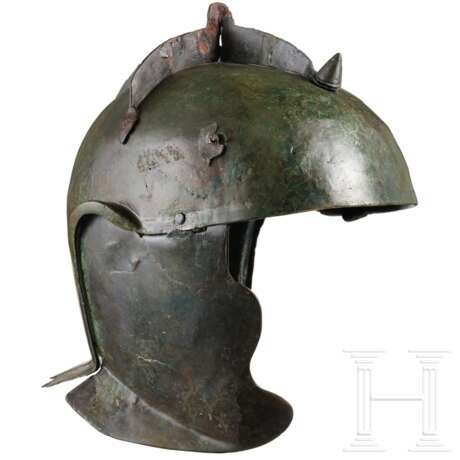ID 1033525
Lot 12 | Römischer Bronzehelm vom Typ Niederbieber, 3. Jhdt. n. Chr.
Estimate value
€ 15 000
Vom Stirnbügel aus Bronzeblech links nur noch das Nietloch zur Befestigung und rechts ein Niet mit dem Ansatz des Bügels erhalten. Inwendig an den Seiten eiserne Scharnierlaschen mit einem Niet befestigt, welche mit den umgebogenen oberen Enden der Wangenklappen ein dreiteiliges Gewerbe bildeten. Nur die rechte Wangenklappe erhalten, unten mit auswärts gestelltem breiten Rand, vorne mit zwei Gesichtsauschnitten. Die Ohren durch die Wangenklappen vollständig in den Ohrenausschnitt hinein abgedeckt. Die erhaltene Wangenklappe innen an vier Punkten modern befestigt. Kalotte und Wangenklappe von innen her mit Gaze und Kunststoff stabilisiert, eine Bruchstelle des bronzenen Längsbügels ebenfalls. Länge ca. 29 cm, Breite ca. 19 cm, Höhe ca. 29 cm.
Späteste und am weitesten entwickelte Form römischer Helme in der Tradition der Exemplare, deren Kalotte aus einem Stück getrieben ist. Zum Zweck der Gewichtsreduzierung extrem dünne und leichte Wandung, welche durch die massiveren Kreuzbügel auf dem Oberteil in Bezug auf Stabilität und Sicherheit verstärkt wurde. In der Zeit um 300 während der Tetrarchie durch neue, völlig andere Konstruktionsprinzipien (Kammhelme mit mehrteiligen Kalotten) abgelöst.
Provenienz: Aus dem Nachlass eines süddeutschen Militaria-Sammlers, erworben 2008 bei Hermann Historica (Auktion 54, Los 365). Zuvor Sammlung Axel Guttman (AG 543/H242), erworben 1994 in Krefeld. Publiziert in Junkelmann, "Römische Helme. Sammlung Axel Guttmann VIII", 2000, S. 158 mit Abb. 81 und 82.
A Roman bronze helmet of the Niederbieber type, 3rd century A.D.
A bronze bowl hammered in one piece, the sides with strikingly flared and stepped ear openings, the back pulled deeply downwards and provided with a neck guard sloping slightly downwards. The neck guard at the rim with heavy chipping, the underside with an incised, cursive owner's inscription. On the crest lengthwise a bronze stirrup, drawn close to the neck guard at the back, fastened at both ends by a rivet with a large, conical head. Transversely across the top of the calotte an iron stirrup held in position by a slot on the top of the bronze stirrup.
From the frontal stirrup of sheet bronze only the rivet hole for fastening on the left and a rivet with the base of the stirrup on the right are preserved. Inside, iron hinge lugs attached to the sides with a rivet, which formed a three-part joint with the bent upper ends of the cheek flaps. Only the right cheek flap survives, with an outwardly set, wide rim at the bottom and two facial cutouts at the front. The ears completely covered by the cheek flaps into the ear cut-out. The preserved cheek flap modernly attached at four points on the inside. The calotte and cheek flap stabilised from the inside with gauze and plastic, a fracture of the bronze longitudinal stirrup as well. Length ca. 29 cm, width ca. 19 cm, height ca. 29 cm.
The latest and most advanced form of Roman helmets in the tradition of examples with the bowl hammered out of one piece. Extremely thin and light wall for the purpose of weight reduction, which was strengthened in terms of stability and safety by the more massive cross-bars on the upper part. In the time around 300, during the Tetrarchy, replaced by new, completely different construction principles (ridge helmets with multi-part bowls).
Provenance: From the estate of a South German military collector, acquired in 2008 at Hermann Historica (auction 54, lot 365). Previously the Axel Guttman Collection (AG 543/H242), acquired in 1994 in Krefeld. Published in Junkelmann, "Römische Helme. Axel Guttmann Collection VIII", 2000, p. 158 with figs. 81 and 82.
Condition: II - III
| Place of origin: | Roman Empire |
|---|
| Place of origin: | Roman Empire |
|---|
| Address of auction |
Hermann Historica Bretonischer Ring 3 85630 Grasbrunn / München Germany | ||||||||||||||
|---|---|---|---|---|---|---|---|---|---|---|---|---|---|---|---|
| Preview |
| ||||||||||||||
| Phone | +49 (0)89 5472 649 0 | ||||||||||||||
| Fax | +49 (0)89 5472 64999 | ||||||||||||||
| Buyer Premium | 25 % | ||||||||||||||
| Conditions of purchase | Conditions of purchase | ||||||||||||||
| Business hours | Business hours
|



